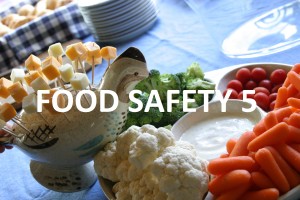It seems that the number of foodborne illness outbreaks is growing lately. Is that due to a more global food supply? Resistant strains of bacteria or microbes? Do we just hear about the cases more than we did in the past because of the growing social media avenues available? Regardless of which or even if all of these are true, it is likely that one in 6 of Americans will come down with a preventable foodborne illness this year. Here are the “Food Safety 5” areas that you should keep in mind to prevent foodborne illnesses:
- Keep Clean – Wash your hands often with warm soap and water, especially if you are preparing or serving food, but even as a consumer. All it can take is one sick person touching surfaces with unclean hands to pass illnesses. Sanitize food preparation and serving surfaces by using either a commercial sanitizing solution or making your own sanitizing solution by mixing 1 tablespoon unscented liquid chlorine bleach with 1 gallon water. Remember to properly wash produce before using.

- Separate Foods – Keep raw and cooked foods separate to prevent cases of illnesses like Salmonella. Be mindful of juices from uncooked meats when shopping, storing, and preparing foods. A new practice I have heard of is having separate knives and cutting boards for meats and for produce. The availability of colorful knives and other kitchen equipment makes this easy now, consider using bright green for produce and red or purple for meats – you will always know which set to use when preparing dinner.
- Cook Foods Thoroughly – Use a food thermometer to destroy harmful germs in the foodborne illness world. Heat beef, lamb and pork to 145°, poultry and leftovers to 165°, ground beef and pork to 160°. If you would like further information on recommended internal food temperatures or how to use a food thermometer go to http://www.foodsafety.gov/keep/basics/cook/index.html.
- Store Food Safely – Store foods at proper temperatures and within recommended use-by dates. Cold and cooked foods should be kept at room temperature no more than 2 hours, 1 hour in extreme heat (like a summer picnic). Remember the danger zone of 40° to 140°. Properly chill foods or maintain hot foods with warming trays or slow cookers.
- Use Available Resources – Use resources available to stay knowledgeable about outbreaks of foodborne illness either in your community or across the nation at establishments you frequent or with food products you use. There are several foodborne illness tracking newsletters you can sign up for. On the local level watch for reports from Health/Restaurant Inspections. Many communities now post these inspections or violations in newspapers or online. Searchable inspection web sites are available in some areas as well.
Be food safe by following the 5 basic guidelines of food safety. While many food related illnesses can be minor for most of us (with intestinal issues or stomach pain), for others the illness can become deadly. We all need to do our part. A few simple steps can prevent unnecessary illness and cut costs for businesses and families. Keep in mind if an establishment is regularly in the news with violations or food related illnesses – you may want to take a break from them for a while.
